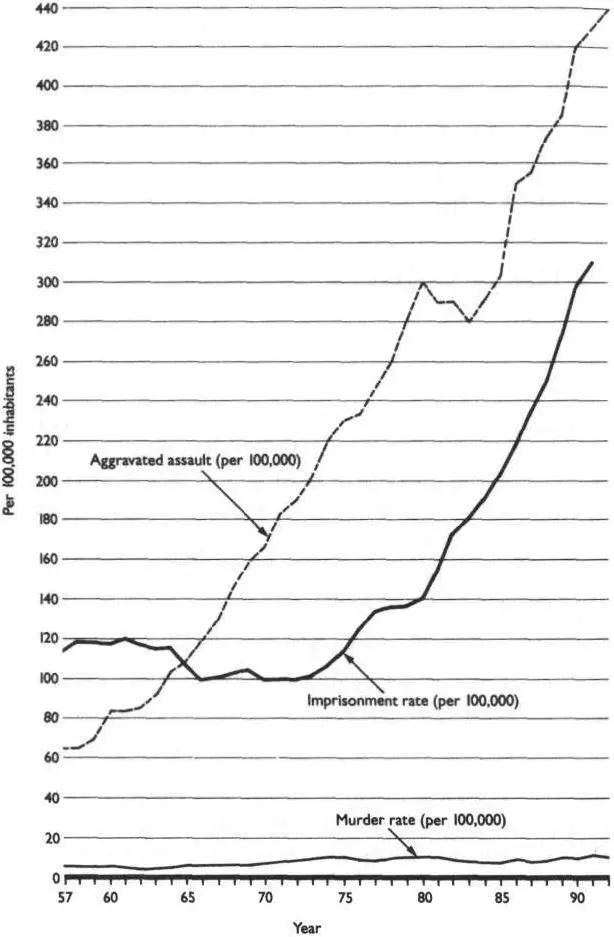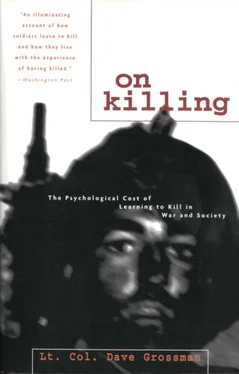Understood not as mindless killers, and not as sniveling whiners, but as men. Men who went to do the incomprehensibly difficult job their nation sent them to do and did it proudly, did it well, and all too often did it thanklessly.
As I interviewed veterans during this study, the soldier, the psychologist, and the human being in me were always touched by this desperate, unspoken need for understanding and affirmation. Understanding that they did no more and no less than their nation and their society asked them to do; no more and no less than 200 years of American veterans had honorably done. And affirmation that they were good human beings.
Over and over again I have said, and before I go on to the final section, “Killing in America,” I want to say again, I am honored that you have shared this with me. You did all that anyone could ask you to have done, and I am truly proud to have known you. And I hope that I can use your words to help people understand.
SECTION VIII
Killing in America:
What Are We Doing to Our Children?
CHAPTER ONE
A Virus of Violence
How simple it now seems for our ancestors to have stood outside their caves guarding against the fang and claw of predators. The evil that we must stand vigilant against is like a virus, starting from deep inside us, eating its way out until we’re devoured by and become its madness.
— Richard Heckler
In Search of the Warrior Spirit
The Magnitude of the Problem
If we examine the chart showing the relationship between murder, aggravated assault, and imprisonment in America since 1957, we see something that should astound us.

The Relationship Between Aggravated Assault, Murder, and Imprisonment Rates in America Since 1957
“Aggravated assault” is defined in the Statistical Abstract (from which this data was gathered) as “assault with intent to kill or for the purpose of inflicting severe bodily injury by shooting, cutting, stabbing, maiming, poisoning, scalding, or by the use of acids, explosives, or other means.” We are also informed that this “excludes simple assaults.” [48]
The aggravated assault rate indicates the incidence of Americans trying to kill one another, and it is going up at an astounding rate. Two major factors serve as tourniquets that suppress the bleeding that would occur if the number of murders increased at the same rate as aggravated assaults. First is the steady increase in the presumably violent percentage of our population that we imprison. The prison population in America has quadrupled since 1975 (from just over two hundred thousand to slightly more than eight hundred thousand in 1992: nearly a million Americans in jail!). Professor John J. Dilulio of Princeton states unequivocally that “dozens of credible empirical analyses… leave no doubt that the increased use of prisons averted millions of serious crimes.” If not for our tremendous imprisonment rate (the highest of any major industrialized nation in the world), the aggravated assault rate and the murder rate would both be even higher.
The other major factor that limits the success of these attempts at killing is the continued progress in medical technology and methodology. Professor James Q. Wilson of UCLA estimates that if the quality of medical care (especially trauma and emergency care) were the same as it was in 1957, today’s murder rate would be three times higher. Helicopter medevacs, 911 operators, paramedics, and trauma centers are but a few of the technological and methodological innovations that save lives at ever-increasing rates. This more rapid and effective response, evacuation, and treatment of victims is the decisive factor in preventing the murder rate from being many times higher than it is now.
It is also interesting to note the dip in aggravated assault rates between 1980 and 1983. Some observers believed this was due to the maturing of the baby-boom generation and the overall aging of America and that violent crime would continue to decrease in succeeding years. However, this did not happen, and, in retrospect, although the aging of our society should cause a decrease in violence, a major factor may have been the sharp increase in the imprisonment rate during that period.
But demographers predict that our aging society will again become more youthful as the children of the baby boom have their own teenagers. And just how much longer can America afford to imprison larger and larger percentages of its population? And how much longer can advances in medical technology continue to keep up with advances in the aggravated assault rate?
Like Alice, we are running as fast as we can to stay where we are. America’s huge imprisonment rate and desperate application of medical progress are technological tourniquets to stop us from bleeding to death in an orgy of violence. But they do so by dealing with the symptoms of the problem rather than the root cause.
The Cause of the Problem: Taking the Safety Catch off of a Nation
We know, as surely as we know that we are alive, that the whole human race is dancing on the edge of the grave….
The easiest and worst mistake we could make would be to blame our present dilemma on the mere technology of war…. It is our attitudes toward war and our uses for it that really demand our attention.
— Gwynne Dyer
War
What is the root cause of this epidemic of violence in our society? An application of the lessons of combat killing may have much to teach us about the constraint and control of peacetime violence. Are the same processes the military used so effectively to enable killing in our adolescent, draftee soldiers in Vietnam being indiscriminately applied to the civilian population of this nation?
The three major psychological processes at work in enabling violence are classical conditioning (a la Pavlov’s dog), operant conditioning (a la B. F. Skinner’s rats), and the observation and imitation of vicarious role models in social learning.
In a kind of reverse Clockwork Orange classical conditioning process, adolescents in movie theaters across the nation, and watching television at home, are seeing the detailed, horrible suffering and killing of human beings, and they are learning to associate this killing and suffering with entertainment, pleasure, their favorite soft drink, their favorite candy bar, and the close, intimate contact of their date.
Operant conditioning firing ranges with pop-up targets and immediate feedback, just like those used to train soldiers in modern armies, are found in the interactive video games that our children play today. But whereas the adolescent Vietnam vet had stimulus discriminators built in to ensure that he only fired under authority, the adolescents who play these video games have no such safeguard built into their conditioning.
And, finally, social learning is being used as children learn to observe and imitate a whole new realm of dynamic vicarious role models, such as Jason and Freddy of endless Friday the 13th and Nightmare on Elm Street sequels, along with a host of other horrendous, sadistic murderers. Even the more classic heroes, such as the archetypal law-abiding police detective, is today portrayed as a murderous, unstable vigilante who operates outside the law.
There are more factors involved. This is a complex, interactive process that includes all the factors that enable killing in combat. Gang leaders and gang members demand violent, even killing, activity and create diffusion of individual responsibility; and gang affiliation, loosening family and religious ties, racism, class differences, and the availability of weapons provide forms of real and emotional distance between the killer and the victim. If we look again at our model for killing-enabling factors and apply it to civilian killing, we can see the way in which all of these factors interact to enable violence in America.
Читать дальше








